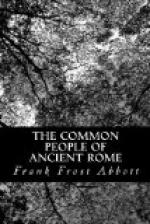In this later period the question of paramount interest is, why did Latin in one part of the world develop into French, in another part into Italian, in another into Spanish? One answer to this question has been based on chronological grounds.[13] The Roman soldiers and traders who went out to garrison and to settle in a newly acquired territory, introduced that form of Latin which was in use in Italy at the time of their departure from the peninsula. The form of speech thus planted there developed along lines peculiar to itself, became the dialect of that province, and ultimately the (Romance) language spoken in that part of Europe. Sardinia was conquered in 241 B.C., and Sardinian therefore is a development of the Latin spoken in Italy in the middle of the third century B.C., that is of the Latin of Livius Andronicus. Spain was brought under Roman rule in 197 B.C., and consequently Spanish is a natural outgrowth of popular Latin of the time of Plautus. In a similar way, by noticing the date at which the several provinces were established down to the acquisition of Dacia in 107 A.D., we shall understand how it was that the several Romance languages developed out of Latin. So long as the Empire held together the unifying influence of official Latin, and the constant intercommunication between the provinces, preserved the essential unity of Latin throughout the world, but when the bonds were broken, the naturally divergent tendencies which had existed from the beginning, but had been held in check, made themselves felt, and the speech of the several sections of the Old World developed into the languages which we find in them to-day.
This theory is suggestive, and leads to several important results, but it is open to serious criticism, and does not furnish a sufficient explanation. It does not seem to take into account the steady stream of emigrants from Italy to the provinces, and the constant transfer of troops from one part of the world to another of which we become aware when we study the history of any single province or legion. Spain was acquired, it is true, in 197 B.C., and the Latin which was first introduced into it was the Latin of Plautus, but the subjugation of the country occupied more than sixty years, and during this period fresh troops were steadily poured into the peninsula, and later on there was frequently an interchange of legions between Spain and the other provinces. Furthermore, new communities of Roman citizens were established there even down into the Empire, and traders were steadily moving into the province. In this way it would seem that the Latin of the early second century which was originally carried into Spain must have been constantly undergoing modification, and, so far as this influence goes, made approximately like the Latin spoken elsewhere in the Empire.




